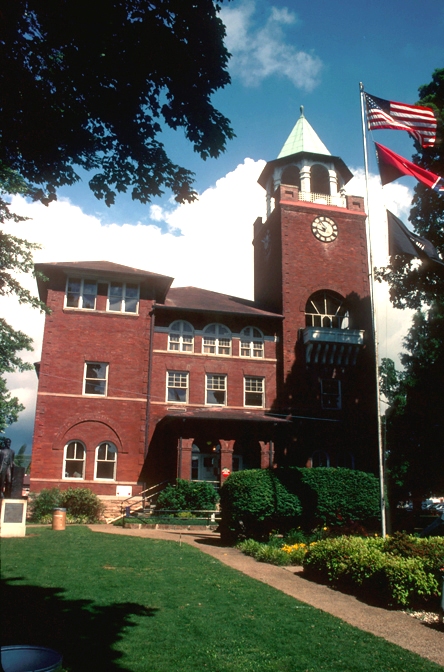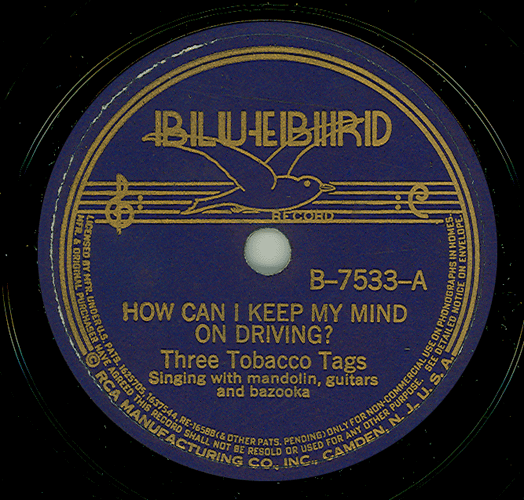|
Howard Armstrong (musician)
Howard "Louie Bluie" Armstrong (March 4, 1909 – July 30, 2003) was an American string band and country blues musician, who played fiddle, mandolin, and guitar and sang. He was also a notable visual artist and raconteur. Early life William Howard Taft Armstrong was born in Dayton, Tennessee, and grew up in LaFollette, Tennessee. He was the middle son from a musically talented family of nine children. His father was also a musician but supported his family with a job in a local steel mill. As a young teenager he taught himself to play the fiddle and joined a band led by Blind Roland Martin and his brother Carl Martin. They toured the United States performing a wide range of music, from work songs and spirituals through popular Tin Pan Alley tunes and foreign-language songs. For a few years, Armstrong attended Tennessee State Normal School as an arts student studying painting and design, while also playing cello in the symphony orchestra as well as fiddle in a jazz band. M ... [...More Info...] [...Related Items...] OR: [Wikipedia] [Google] [Baidu] |
Dayton, Tennessee
Dayton is a city and county seat in Rhea County, Tennessee, United States. As of the 2020 census, the city population was 7,065. The Dayton Urban Cluster, which includes developed areas adjacent to the city and extends south to Graysville. Dayton was the site of the Scopes Trial in 1925 dealing with the creation–evolution controversy. History The community was originally settled ''circa'' 1820 as Smith's Crossroads. In 1877, the town was renamed Dayton, after Dayton, Ohio. The town was incorporated in 1903. Early industry included manufacture of pig iron. Scopes trial In 1925, the famous Scopes Trial was held in Dayton and, for a period of time, filled the town with hucksters of every description and journalists from around the world. The participants included William Jennings Bryan in the role of prosecutor and Clarence Darrow as the principal defense counsel. The trial was over the issue of whether evolution should be taught in public schools. John T. Scopes, the defe ... [...More Info...] [...Related Items...] OR: [Wikipedia] [Google] [Baidu] |
Ted Bogan
Theodore R. Bogan (May 10, 1909 – January 29, 1990) was an American country blues guitarist, singer and songwriter, best known for his work with Howard Armstrong and Carl Martin. His career spanned over 50 years. His finger-picking guitar style was much admired. He played in various string bands for most of his career, including Martin, Bogan & Armstrong (or Martin, Bogan & the Armstrongs). Biography Bogan was born in Spartanburg, South Carolina. He learned to play a finger-picking style of guitar in his adolescence, being initially influenced by Leroy Carr and Blind Blake, both of whom he heard on his family's Antique radio, radio set. It is claimed that he began performing in a medicine show, and appeared on radio broadcasts in Spartanburg. After meeting Carl Martin, Bogan moved to Knoxville, Tennessee. They played extensively on street corners, with Bogan enhancing his guitar playing to incorporate flatpicking. His first recordings were made for Bluebird Records in 1934, ... [...More Info...] [...Related Items...] OR: [Wikipedia] [Google] [Baidu] |
National Endowment For The Arts
The National Endowment for the Arts (NEA) is an independent agency of the United States federal government that offers support and funding for projects exhibiting artistic excellence. It was created in 1965 as an independent agency of the federal government by an act of the U.S. Congress, signed by President Lyndon B. Johnson on September 29, 1965 (20 U.S.C. 951). It is a sub-agency of the National Foundation on the Arts and the Humanities, along with the National Endowment for the Humanities, the Federal Council on the Arts and the Humanities, and the Institute of Museum and Library Services. The NEA has its offices in Washington, D.C. It was awarded Tony Honors for Excellence in Theatre in 1995, as well as the Special Tony Award in 2016. In 1985, the NEA won an honorary Oscar from the Academy of Motion Picture Arts and Sciences for its work with the American Film Institute in the identification, acquisition, restoration and preservation of historic films. In 2016 and again in 2 ... [...More Info...] [...Related Items...] OR: [Wikipedia] [Google] [Baidu] |
National Heritage Fellowship
The National Heritage Fellowship is a lifetime honor presented to master folk and traditional artists by the National Endowment for the Arts. Similar to Japan's Living National Treasure award, the Fellowship is the United States government's highest honor in the folk and traditional arts. It is a one-time only award and fellows must be living citizens or permanent residents of the United States. Each year, fellowships are presented to between nine and fifteen artists or groups at a ceremony in Washington, D.C. The Fellows are nominated by individual citizens, with an average of over 200 nominations per year. From that pool of candidates, recommendations are made by a rotating panel of specialists, including one layperson, as well as folklorists and others with a variety of forms of cultural expertise. The recommendations are then reviewed by the National Council on the Arts, with the final decisions made by the chairperson of the National Endowment for the Arts. As of 2022, 46 ... [...More Info...] [...Related Items...] OR: [Wikipedia] [Google] [Baidu] |
Terry Zwigoff
Terry Zwigoff (born May 18, 1949) is an American filmmaker whose work often deals with misfits, antiheroes, and themes of alienation. He first garnered attention for his work in documentary filmmaking with ''Louie Bluie'' (1985) and '' Crumb'' (1995). After ''Crumb'', Zwigoff moved on to write and direct fiction feature films, including the Academy Award-nominated '' Ghost World'' (2001) and ''Bad Santa'' (2003). Life and career Early life and education Zwigoff was born in Appleton, Wisconsin, to a Jewish family of dairy farmers. He was raised in Chicago. Underground comix scene Zwigoff moved to San Francisco in the 1970s and met cartoonist Robert Crumb, who shared his interest in pre-war American roots music. Zwigoff, who plays cello and mandolin (as well as the saw, and the Stroh violin), joined Crumb’s string band R. Crumb & His Cheap Suit Serenaders, with whom he recorded several records. Zwigoff's friendship with Crumb led to his involvement in the underground comix ... [...More Info...] [...Related Items...] OR: [Wikipedia] [Google] [Baidu] |
Auto Industry
The automotive industry comprises a wide range of companies and organizations involved in the design, development, manufacturing, marketing, and selling of motor vehicles. It is one of the world's largest industries by revenue (from 16 % such as in France up to 40 % to countries like Slovakia). It is also the industry with the highest spending on research & development per firm. The word ''automotive'' comes from the Greek ''autos'' (self), and Latin ''motivus'' (of motion), referring to any form of self-powered vehicle. This term, as proposed by Elmer Sperry (1860-1930), first came into use with reference to automobiles in 1898. History The automotive industry began in the 1860s with hundreds of manufacturers that pioneered the horseless carriage. For many decades, the United States led the world in total automobile production. In 1929, before the Great Depression, the world had 32,028,500 automobiles in use, and the U.S. automobile industry produced over 90% of th ... [...More Info...] [...Related Items...] OR: [Wikipedia] [Google] [Baidu] |
World War II
World War II or the Second World War, often abbreviated as WWII or WW2, was a world war that lasted from 1939 to 1945. It involved the vast majority of the world's countries—including all of the great powers—forming two opposing military alliances: the Allies and the Axis powers. World War II was a total war that directly involved more than 100 million personnel from more than 30 countries. The major participants in the war threw their entire economic, industrial, and scientific capabilities behind the war effort, blurring the distinction between civilian and military resources. Aircraft played a major role in the conflict, enabling the strategic bombing of population centres and deploying the only two nuclear weapons ever used in war. World War II was by far the deadliest conflict in human history; it resulted in 70 to 85 million fatalities, mostly among civilians. Tens of millions died due to genocides (including the Holocaust), starvation, ma ... [...More Info...] [...Related Items...] OR: [Wikipedia] [Google] [Baidu] |
George Gershwin
George Gershwin (; born Jacob Gershwine; September 26, 1898 – July 11, 1937) was an American composer and pianist whose compositions spanned popular, jazz and classical genres. Among his best-known works are the orchestral compositions ''Rhapsody in Blue'' (1924) and ''An American in Paris'' (1928), the songs " Swanee" (1919) and "Fascinating Rhythm" (1924), the jazz standards "Embraceable You" (1928) and "I Got Rhythm" (1930), and the opera ''Porgy and Bess'' (1935), which included the hit " Summertime". Gershwin studied piano under Charles Hambitzer and composition with Rubin Goldmark, Henry Cowell, and Joseph Brody. He began his career as a song plugger but soon started composing Broadway theater works with his brother Ira Gershwin and with Buddy DeSylva. He moved to Paris, intending to study with Nadia Boulanger, but she refused him, afraid that rigorous classical study would ruin his jazz-influenced style; Maurice Ravel voiced similar objections when Gershwin inq ... [...More Info...] [...Related Items...] OR: [Wikipedia] [Google] [Baidu] |
Elijah Wald
Elijah Wald (born 1959) is an American folk blues guitarist and music historian. He is a 2002 Grammy Award winner for his liner notes to ''The Arhoolie Records 40th Anniversary Box: The Journey of Chris Strachwitz''. Life Wald was born in 1959 in Cambridge, Massachusetts.Elijah Wald P.O.V. Borders – Border Talk, PBS, 2002. Accessed online 2009-10-01. His parents were George Wald (co-recipient of the 1967 ) and |
Bluebird Records
Bluebird Records is a record label best known for its low-cost releases, primarily of kids' music, blues and jazz in the 1930s and 1940s. It was founded in 1932 as a lower-priced RCA Victor subsidiary label of RCA Victor. Bluebird became known for what came to be known as the "Bluebird sound", which influenced rhythm and blues and early rock and roll. It is currently owned by parent company Sony Music Entertainment. History The label was founded in 1932 as a division of RCA Victor by Eli Oberstein, an executive at the company. Bluebird competed with other budget labels at the time. Records were made quickly and cheaply. The "Bluebird sound" came from the session band that was used on many recordings to cut costs. The band included musicians such as Big Bill Broonzy, Roosevelt Sykes, Washboard Sam, and Sonny Boy Williamson. Many blues musicians were signed to RCA Victor and Bluebird by Lester Melrose, a talent scout and producer who had a virtual monopoly on the Chicago blues ... [...More Info...] [...Related Items...] OR: [Wikipedia] [Google] [Baidu] |
1933 World's Fair
A Century of Progress International Exposition, also known as the Chicago World's Fair, was a world's fair held in the city of Chicago, Illinois, United States, from 1933 to 1934. The fair, registered under the Bureau International des Expositions (BIE), celebrated the city's centennial. The theme of the fair was technological innovation, and its motto was "Science Finds, Industry Applies, Man Adapts", trumpeting the message that science and American life were wedded. Its architectural symbol was the Sky Ride, a transporter bridge perpendicular to the shore on which one could ride from one side of the fair to the other. One description of the fair noted that the world, "then still mired in the malaise of the Great Depression, could glimpse a happier not-too-distant future, all driven by innovation in science and technology." Fair visitors saw the latest wonders in rail travel, automobiles, architecture and even cigarette-smoking robots. The exposition "emphasized technology and ... [...More Info...] [...Related Items...] OR: [Wikipedia] [Google] [Baidu] |





